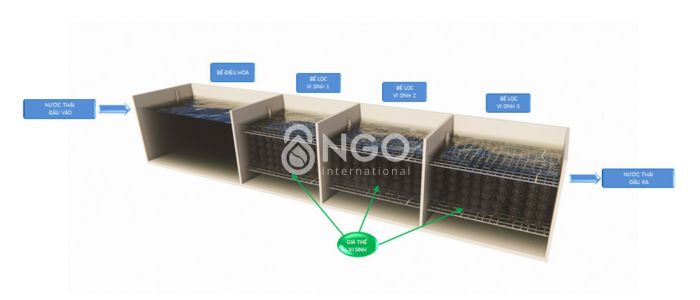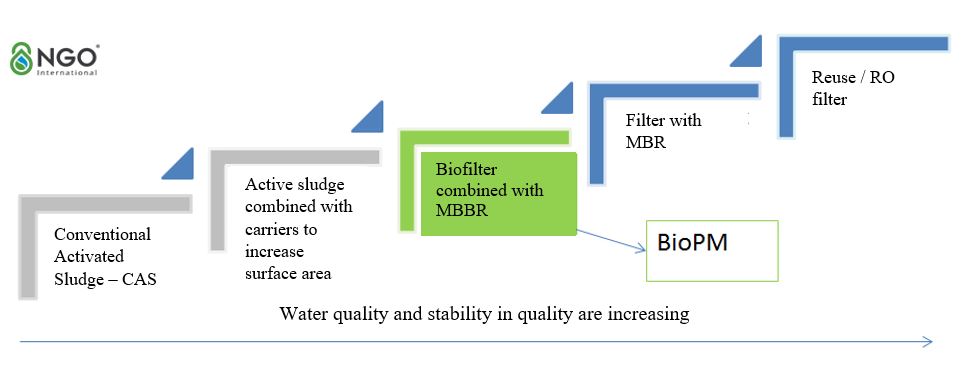BioPM - SOLUTIONS TO ORGANIC INDUSTRIAL WASTEWATER TREATMENT
BioPM (Biofilter for production & manufacturing) is an organic industrial wastewater treatment solution by filtering through microbiological membranes, with superior efficiency compared to traditional microbiological sludge method, high filtration efficiency makes water easy easily reach A or reusable with large input fluctuation threshold. In addition, this solution does not require strict control of viscosity and microbial density, does not require reflux or sedimentation, helping the operator to be freed from many responsibilities.

1. Who is BioPM suitable for?
- BioPM is particularly effective when applied to processing and manufacturing businesses whose wastewater sources have a high organic content of plants and animals (usually BOD/COD ≥0.2), for example:
- Enterprises processing food and aquatic products
- Enterprises producing beverages and alcohol
- Coffee manufacturers
- Industrial parks, businesses with high number of employees
- Municipal domestic wastewater treatment system.....
2. What value added does BioPM bring to customers?
- Construction cost is reduced by 50% due to extremely small basin volume
- The cost of sludge treatment is very low, because the amount of sludge generated is much less than that of the suspended microbiological sludge method. Some projects have been implemented this method even without the sludge basin due to very little sludge, which helps saving operating costs
- Overcoming difficulties when the input pollution concentration is not balanced (COD/TN, BOD/TN)
- Low power consumption due to optimized flow and dynamics design
- Thoroughly treating TN in wastewater thanks to anaerobic microbial membrane formed in the filtration layer
- It can eliminate the foaming phenomenon in the output effluent when the amount of surfactant (e.g. detergent, soap) is high, the effect of surfactant treatment is better than the activated sludge method and the MBR filter
- Withstands up to 20% -30% of input fluctuations in capacity or concentration
- Create a suitable environment to select natural microorganisms, retain microorganisms with high sludge lifetime, and eliminate fast-growing and difficult-to-settle microorganisms when being discharged into the environment.
- Increase the efficiency of gas distribution of the distribution system when discharging from the wastewater environment to microorganisms due to the gas flow in zigzag, not straight lines.
3. How does BioPM work?
- BioPM treats pollutants through biofilter basins, including part or full of filtration steps: anaerobic filtration, anoxic filtration, aerobic filtration. Water flow is designed from the bottom up. After going through these filters, organic pollutants and nutrients are thoroughly treated to satisfy A-QCVN40: 2011/BTNMT standards.
- Because of the filtration mechanism, the treatment system does not require sedimentation basins before being discharged into the environment. Sludge is maintained in the filter layer instead of floating in wastewater, so the water quality is stable even when sludge is not capable of forming particles or has good sedimentation, reducing complexity in transportation compared to current activated sludge technology.
- The difference when applying BioPM to different types of production wastewater is in the pretreatment step (level 1 treatment), depending on the specific nature of the wastewater, the pretreatment steps will be designed accordingly.
4. What is the required volume for the processing system?
- The volume will be optimally designed based on: (i) size of discharge, (ii) nature of continuous discharge or at a specific time, (iii) the pretreatment steps depending on the characteristics of wastewater, for example: screening, regulating PH, etc. (iv) concentration of COD in wastewater and (v) actual customer space.
- To save space, the micro-filtration layer can be designed to increase the density of microorganisms to be treated; thereby helping the amount of pollutants that can be treated per 1m2 of basin increase. Usually the volume is ~ 1.2Q - 2Q (Q = discharge capacity / day and night). If the wastewater is particularly polluted, (e.g. COD ≥ 10,000mg / l), the retention time will be higher.
5. How is BioPM different from other technologies?

If your business is interested in solution to inlet water treatment, or has a demand for ion exchange materials, please contact NGO via phone number (024) 3566 8225 or email office@8ngo.com for direct consultation.
-
 Wastewater treatment
Wastewater treatment
-
 A standard domestic wastewater
A standard domestic wastewater
-
 B standard domestic wastewater
B standard domestic wastewater
-
 Pig Farm Wastewater
Pig Farm Wastewater
-
 Textile dyeing wastewater
Textile dyeing wastewater
-
 Paper industry wastewater solution
Paper industry wastewater solution
-
 Textile Dyeing Wastewater & Industrial Washing
Textile Dyeing Wastewater & Industrial Washing
-
 Slaughter wastewater treatment solution
Slaughter wastewater treatment solution
-
 Aquaculture wastewater
Aquaculture wastewater
-
 Starch wastewater
Starch wastewater
-
 Petroleum wastewater
Petroleum wastewater
-
 Beer wastewater
Beer wastewater
-
 Other industrial wastewaters
Other industrial wastewaters
-
 BioPM - Organic Industrial wastewater treatment solution
BioPM - Organic Industrial wastewater treatment solution
-
 MBR solutions
MBR solutions
-
 Conventional activated sludge (CAS)
Conventional activated sludge (CAS)
-
 Moving bed biofilm reactor (MBBR)
Moving bed biofilm reactor (MBBR)
-
 Anaerobic- Anoxic-Aerobic (AAO)
Anaerobic- Anoxic-Aerobic (AAO)
-
 Sequencing batch reactor (SBR)
Sequencing batch reactor (SBR)
-
 Physical & Chemical methods
Physical & Chemical methods
-
 Supply water treatment
Supply water treatment
-
 Cooling system water
Cooling system water
-
 Water treatment for food and Beverage production
Water treatment for food and Beverage production
-
 Ultra pure water supply solution for electronic industry
Ultra pure water supply solution for electronic industry
-
 Pure water supply for pharmaceutical manufacturers
Pure water supply for pharmaceutical manufacturers
-
 Water Supply treatment with ion exchange method
Water Supply treatment with ion exchange method
-
 Ordor Treatment
Ordor Treatment

